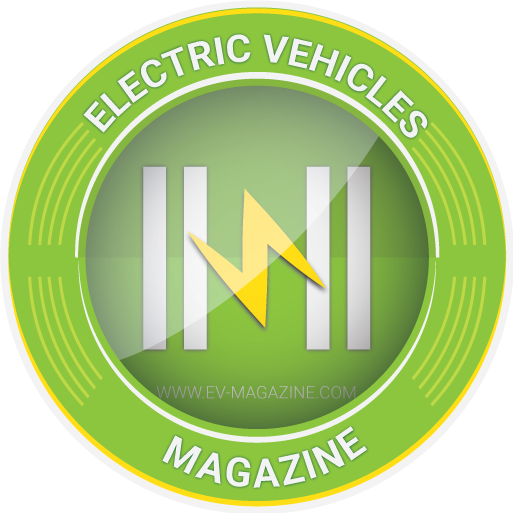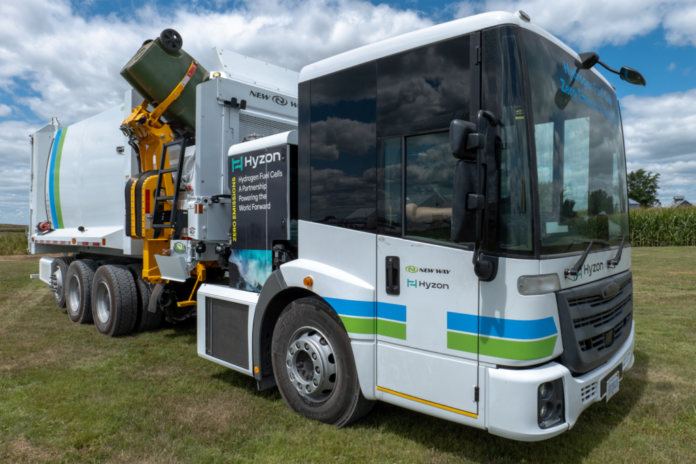Nearly every sector on the heavy-duty side of trucking faces significant obstacles to decarbonization. Transitioning from diesel to electric involves substantial changes to established operating practices. Reduced payloads, shorter runs, and the staggering cost of the equipment and the necessary infrastructure are not the best motivators for change.
The refuse sector, however, will soon have an alternative to compressed natural gas (CNG) or diesel that could make the zero-emission transition practically seamless: hydrogen fuel cells.
Interest in hydrogen-powered refuse collection has grown significantly since New Way and Hyzon debuted their first-of-its-kind hydrogen fuel cell electric refuse collection vehicle at Waste Expo in May 2024. Demonstrations have been scheduled with customers into early 2025. (Photo: Hyzon)
Refuse body builder, New Way, and fuel cell maker, Hyzon, inked a joint development agreement earlier this year to build and test North America’s first fuel cell-powered refuse truck.
Hyzon has been running a fuel cell-powered refuse truck in Australia since the fall of 2023.
“That truck has shown great range and great opportunity,” said Steven Boyer, vice-president, commercial, at Hyzon. “We’ve been able to do 1,200 cans or more in a day, with over 100 miles of range as well. It has demonstrated all the operational characteristics that we expect from a refuse truck.”
The North American prototype is currently in San Fransisco, Calif., for testing and evaluation by refuse company, Recology. It will be evaluated in other Bay-area cities throughout the fall.
Sometime later this year, lucky residents of some Edmonton neighborhoods will be able to sleep through garbage day. New Way and Hyzon will be conducting field tests of this nearly silent refuse truck in the dead of winter to prove its cold weather performance.
The trouble with batteries
Batteries present several problems for waste haulers. First, is the weight. Payload is always an issue in this sector, and the additional weight of the batteries can put these trucks overweight on some collection routes. Weight distribution is an issue as well. There’s not a lot of open space on a refuse chassis, so distributing the weight of the batteries evenly on all the axles can be challenging.
Reduced operating range and lengthy charging times are two more inhibitors to an easy transition away from fossil fuels in this sector.
Bruce Kurtt, Hyzon’s senior vice-president, commercial, for North America, told TruckNews.com the fuel cell truck it is testing is 4,000-5,000 lb. lighter than a battery truck, but can still manage 100-125 miles on a fill while picking up 1,000-1,200 trash cans on residential routes.
“Looking back, we learned some lessons from the transit bus sector when they migrated over to battery power,” he said. “It messed up their operations. They couldn’t keep operating the same way they did. One solution was to buy more buses, but that’s expensive, and eventually they ran out of room to park them while they were charging.”
The fuel cell option won’t quite achieve weight parity with a traditional powertrain, but it comes close.
“We are within a few thousand pounds,” said Tyler White, product manager, mobile refuse equipment New Way Trucks. “The U.S. federal regulations grant a 2,000-lb. weight allowance for zero emissions or alternate energy trucks, so our target is to be within that.”
Unfortunately, most of Canada doesn’t yet offer similar allowances. Currently, B.C. offers a 1,500-kg exemption for battery electric trucks and 1,000-kg for fuel cell vehicles.
Alberta will issue an overweight permit for such vehicles, but the tolerance is limited to 300 kg on the steer axle and 700 kg on drive axles. Gross weight limits do not change.
And they wonder why trucking isn’t diving right in on alternate fuels. But I digress.
Similarities to CNG
A great number of refuse trucks are already powered by CNG, so transitioning to another gaseous fuel, hydrogen, is less of a stretch than converting directly from diesel.
As long-time consumers of CNG, fleets are familiar with pressure vessels and the handling of gaseous fuels.
The hydrogen storage tanks on this truck mount in the same place the CNG tanks are today. Kurtt said the tanks even have the same part number, although they’re filled to 5,000 psi rather than the 3,600-3,800 psi common with CNG. Current tanks can hold 25 kg of hydrogen at 350 bar (5,000 psi).
The fueling process is similar to that of CNG and takes 15-20 minutes.
The elegance of this solution lies in the similarity to a CNG drivetrain compared to that of a fuel cell drivetrain. It’s almost a plug-and-play design.
The chassis is an off-the-shelf Freightliner EconicSD (Freightliner’s dedicated refuse chassis), minus the engine, transmission and driveshaft. The drive axles are stock. (Freightliner is not directly involved in this conversion.)
“We use the OEM drive shaft, axles, brakes, and suspensions,” Kurtt explained. “That engineering is already done. We don’t need to modify any of that.”
The heart of the system, the fuel cell itself, sits roughly where the CNG or diesel engine would sit. The distribution block that supplies electricity to the various systems sits directly behind the fuel cell. The electric motor and four-speed transmission sit between the frame rails in roughly the same location the transmission would be with a diesel or CNG engine.
The whole fuel cell system consists of 10 separate modules, all designed in-house by Hyzon. These are installed by the mod shop when the body is mounted on the chassis.
Hyzon’s 200-kW fuel cell system will run at about 50-70% of capacity, which is the sweet spot for efficiency. (Photo: Hyzon)
The hydrogen fuel cell
The heart of the system is a 200-kW single-stack fuel cell, designed by Hyzon. Kurtt says 200 kilowatts is, “kind of overkill for this refuse application,” but over-spec’ing allows the fuel cell to run at about 50-70% of its output capacity.
“That’s its sweet spot,” Kurtt said. “It’s like a diesel engine; just because it’ll turn 1,800 rpm you don’t want to run there all the time. It’s more efficient at 1,300 or something. Fuel cells work the same way.”
The fuel cell doesn’t drive the truck directly. It just maintains a charge in the battery. The battery is much smaller than a full battery-electric truck, and so the fuel cell runs much of the time.
But on a collection route, for example, when the truck is lurching from can to can, the truck would likely be running on batteries alone, capturing the benefit of regenerative braking. The fuel cell would likely be shut off. It would restart to bring the batteries up to charge if necessary.
The batteries used on this truck are designed specifically to react very quickly to charge and discharge cycles. Kurtt called them “3 C batteries.”
“It is a function of the battery chemistry; a measurement of the charge and discharge rate. It can be different between charge and discharge. There is also continuous and peak,” he explained. “Our batteries charge at 2 C continuous, 3 C peak. We discharge at 3 C continuous and 5 C peak.”
The fuel cell also powers compactor components. The mechanism remains hydraulic, but rather than a conventional PTO mounted on the transmission, cables run from the main power distribution block to an electric motor which drives the hydraulic pump for the body.
Hyzon says the onboard storage capacity, using existing CNG tanks, can power the truck up to 125 miles with up to 1,200 cart lifts per shift. (Photo: New Way)
New Way’s 31-XL SideWinder
The refuse body is New Way Truck’s latest innovation, the 31-XL side-loader. It has a 31 cubic yard capacity, with a 6 cubic-yard hopper. The side arm has a 12-foot reach. White says there are now 20-30 of these in service around the U.S. with diesel or CNG power.
“The body on the fuel cell chassis the same body, with the same control system. The only significant difference is the e-PTO versus the hydraulic PTO used on the CNG trucks,” he said. “That came directly from our experience with battery-electric trucks.
“There’s an additional advantage to the e-PTO,” White added. “The pump rpm isn’t constantly fluctuating as it does with an internal combustion engine and transmission-style PTO. You can dial it in to whatever efficiency point you want or need. There will be some maintenance savings there as well.”
From the driver’s perspective, the controls and functionality are exactly the same as a CNG version. The driver won’t have to adapt to the fuel cell-powered truck, except to learn how to squeeze the most efficiency from the regen braking capability.
“Based on what we’ve heard from drivers operating battery electric trucks, the love the fact that it’s so quiet in the cab, and it’s cooler in there because they are not sitting right over or beside the engine,” noted Eric Evans, chief product officer for New Way Trucks.
The New Way/Hyzon fuel cell refuse truck is currently doing field tests and customer evaluations in the San Francisco Bay area. Further tests and demonstrations are planned in Edmonton throughout the winter. (Photo: Hyzon)
Chassis-agnostic future
While the truck that’s currently making the rounds for testing and evaluation, both Hyzon and New Way are already talking about expanding to other OEM chassis.
The Freightliner EconicSD is a European design that’s currently shipped all over the world. It first appeared in North America five or six years ago. It’s Daimler’s dedicated refuse chassis. To capture a larger share of the market, Hyzon and New Way will have to integrate with refuse chassis from the likes of Autocar, Mack, Peterbilt and others.
New Way already has established relationships with those companies, so if the field tests and customer evaluations go as planned, it will be a matter doing the engineering to make everything fit onto a few other chassis.
The field testing planned for Edmonton will get underway later this year, but no dates, specific locations, or partners have been announced.
The partnership between fuel cell maker, Hyzon and refuse body builder, New Way, represents an opportunity for CNG-powered refuse fleets to transition to zero-emissions with little technical effort and almost no loss of productivity. (Photo: Hyzon)
Hyzon/New Way Refuse Truck Spec’s
Fuel-cell-electric powertrain spec’s:
Typical driving range: 125 miles/200 km (Including 1,200 collecting cycles)
Electric motor power: 240kW (320 hp) continuous, 360kW (482 hp) peak
Electric motor torque: 960lb-ft continuous, 1475 lb-ft peak
High voltage battery energy: 55 kWh
Powertrain voltage: 615 volt
Maximum speed: 55 mph (88 km/h)
Fuel cell power: 200 kW
On-board hydrogen: 25 kg
Working pressure cylinders: 350 bar
Refueling time: 15 minutes
Chassis spec’s:
Chassis: Freightliner EconicSD
GCWR: 64,000 lbs.
Payload: 32,000 lbs.
Wheelbase: 192”, 204”, or 216”
Compactor body:
New Way Trucks’ automated side loader, Sidewinder XL
Smooth arm operation, 12-foot reach, 6-cubic-yard hopper
31 cubic yard capacity

Source link
#Hyzon #test #hydrogen #fuel #cell #refuse #truck #Edmonton





